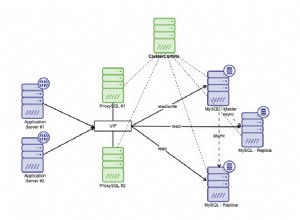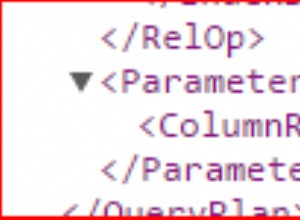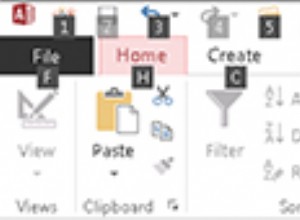Ho pensato di utilizzare CTE ricorsivo
, ma, per quanto ne so, non è possibile in SQL Server utilizzare UNION per connettere un membro di ancoraggio e un membro ricorsivo di CTE ricorsivo (penso che sia possibile farlo in PostgreSQL), quindi non è possibile eliminare i duplicati.
declare @i int
with cte as (
select
GroupID,
row_number() over(order by Company) as rn
from Table1
)
update cte set GroupID = rn
select @i = @@rowcount
-- while some rows updated
while @i > 0
begin
update T1 set
GroupID = T2.GroupID
from Table1 as T1
inner join (
select T2.Company, min(T2.GroupID) as GroupID
from Table1 as T2
group by T2.Company
) as T2 on T2.Company = T1.Company
where T1.GroupID > T2.GroupID
select @i = @@rowcount
update T1 set
GroupID = T2.GroupID
from Table1 as T1
inner join (
select T2.Publisher, min(T2.GroupID) as GroupID
from Table1 as T2
group by T2.Publisher
) as T2 on T2.Publisher = T1.Publisher
where T1.GroupID > T2.GroupID
-- will be > 0 if any rows updated
select @i = @i + @@rowcount
end
;with cte as (
select
GroupID,
dense_rank() over(order by GroupID) as rn
from Table1
)
update cte set GroupID = rn
Ho anche provato un algoritmo di ricerca in ampiezza. Ho pensato che potesse essere più veloce (è migliore in termini di complessità), quindi fornirò una soluzione qui. Tuttavia, ho scoperto che non è più veloce dell'approccio SQL:
declare @Company nvarchar(2), @Publisher nvarchar(2), @GroupID int
declare @Queue table (
Company nvarchar(2), Publisher nvarchar(2), ID int identity(1, 1),
primary key(Company, Publisher)
)
select @GroupID = 0
while 1 = 1
begin
select top 1 @Company = Company, @Publisher = Publisher
from Table1
where GroupID is null
if @@rowcount = 0 break
select @GroupID = @GroupID + 1
insert into @Queue(Company, Publisher)
select @Company, @Publisher
while 1 = 1
begin
select top 1 @Company = Company, @Publisher = Publisher
from @Queue
order by ID asc
if @@rowcount = 0 break
update Table1 set
GroupID = @GroupID
where Company = @Company and Publisher = @Publisher
delete from @Queue where Company = @Company and Publisher = @Publisher
;with cte as (
select Company, Publisher from Table1 where Company = @Company and GroupID is null
union all
select Company, Publisher from Table1 where Publisher = @Publisher and GroupID is null
)
insert into @Queue(Company, Publisher)
select distinct c.Company, c.Publisher
from cte as c
where not exists (select * from @Queue as q where q.Company = c.Company and q.Publisher = c.Publisher)
end
end
Ho testato la mia versione e quella di Gordon Linoff per verificare come si comporta. Sembra che CTE sia molto peggio, non potevo aspettare che fosse completo su più di 1000 righe.
Ecco sql fiddle demo
con dati casuali. I miei risultati sono stati:
128 righe :
la mia soluzione RBAR:190 ms
la mia soluzione SQL:27 ms
Soluzione di Gordon Linoff:958 ms
256 righe :
la mia soluzione RBAR:560 ms
la mia soluzione SQL:1226 ms
Soluzione di Gordon Linoff:45371 ms
Sono dati casuali, quindi i risultati potrebbero non essere molto coerenti. Penso che la tempistica possa essere modificata dagli indici, ma non credo che potrebbe cambiare un'intera immagine.
vecchio versione - utilizzando la tabella temporanea, calcolando semplicemente GroupID senza toccare la tabella iniziale:
declare @i int
-- creating table to gather all possible GroupID for each row
create table #Temp
(
Company varchar(1), Publisher varchar(1), GroupID varchar(1),
primary key (Company, Publisher, GroupID)
)
-- initializing it with data
insert into #Temp (Company, Publisher, GroupID)
select Company, Publisher, Company
from Table1
select @i = @@rowcount
-- while some rows inserted into #Temp
while @i > 0
begin
-- expand #Temp in both directions
;with cte as (
select
T2.Company, T1.Publisher,
T1.GroupID as GroupID1, T2.GroupID as GroupID2
from #Temp as T1
inner join #Temp as T2 on T2.Company = T1.Company
union
select
T1.Company, T2.Publisher,
T1.GroupID as GroupID1, T2.GroupID as GroupID2
from #Temp as T1
inner join #Temp as T2 on T2.Publisher = T1.Publisher
), cte2 as (
select
Company, Publisher,
case when GroupID1 < GroupID2 then GroupID1 else GroupID2 end as GroupID
from cte
)
insert into #Temp
select Company, Publisher, GroupID
from cte2
-- don't insert duplicates
except
select Company, Publisher, GroupID
from #Temp
-- will be > 0 if any row inserted
select @i = @@rowcount
end
select
Company, Publisher,
dense_rank() over(order by min(GroupID)) as GroupID
from #Temp
group by Company, Publisher




